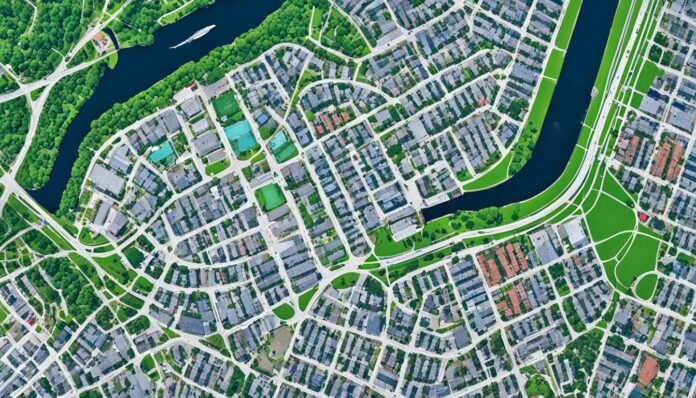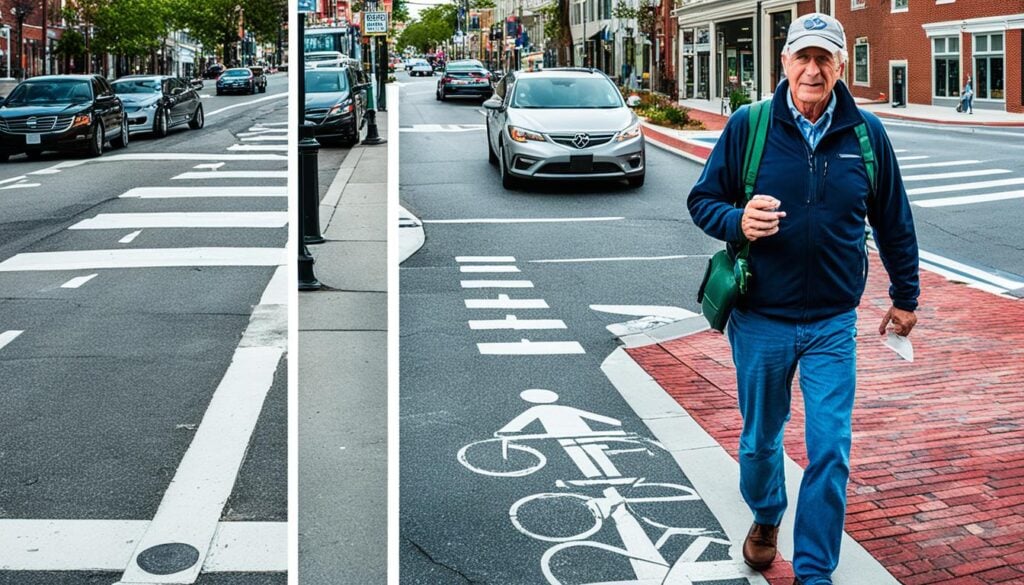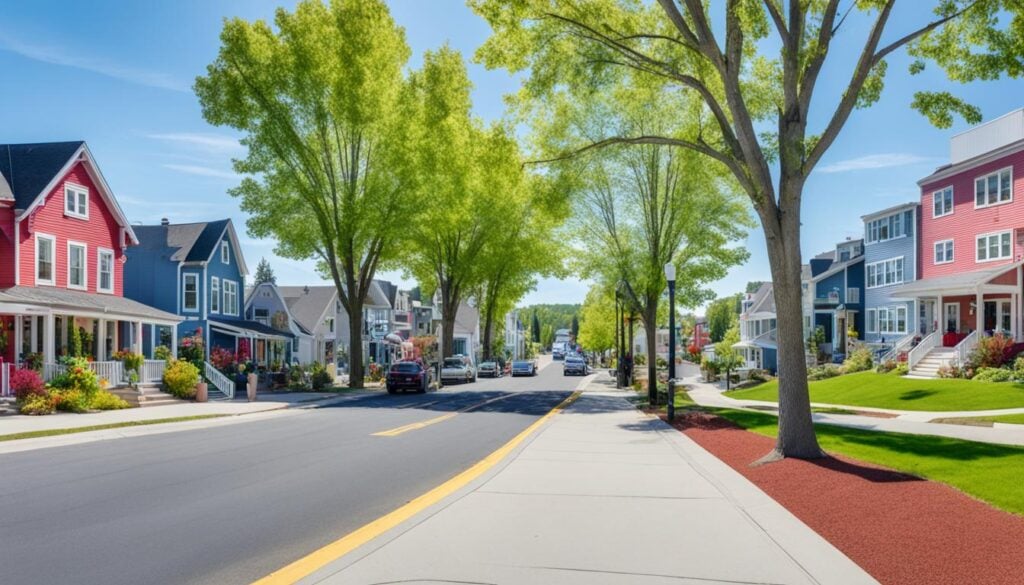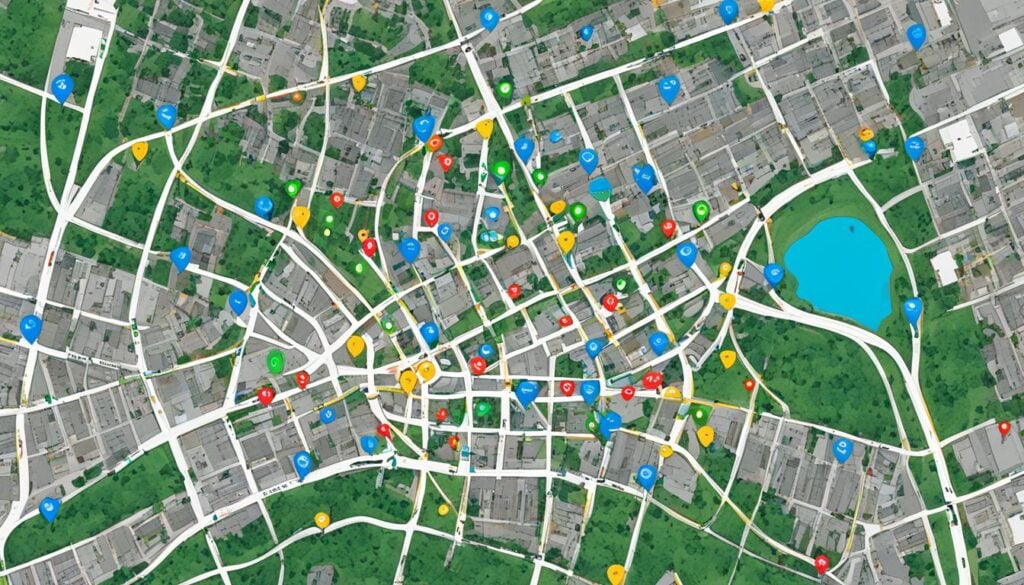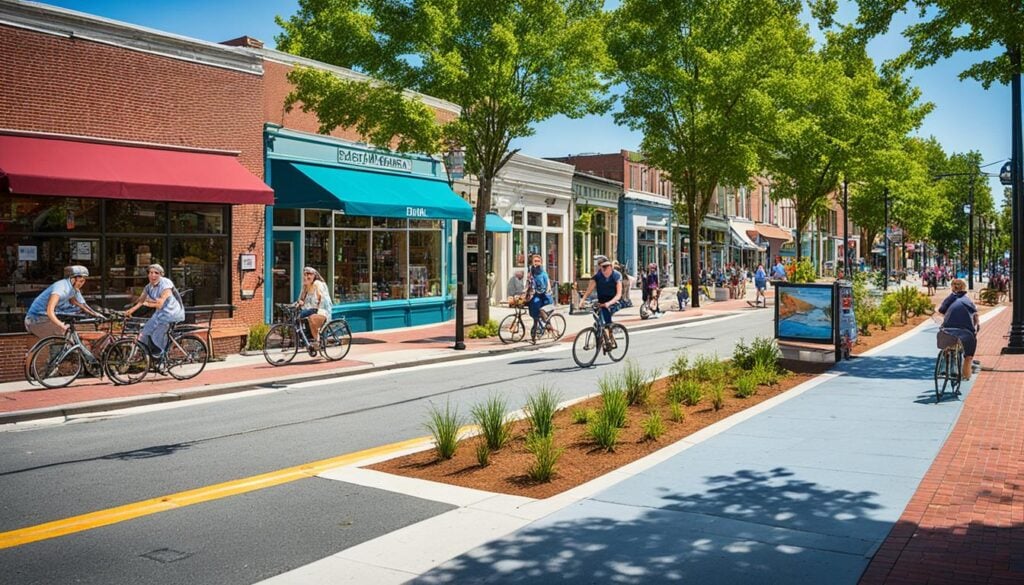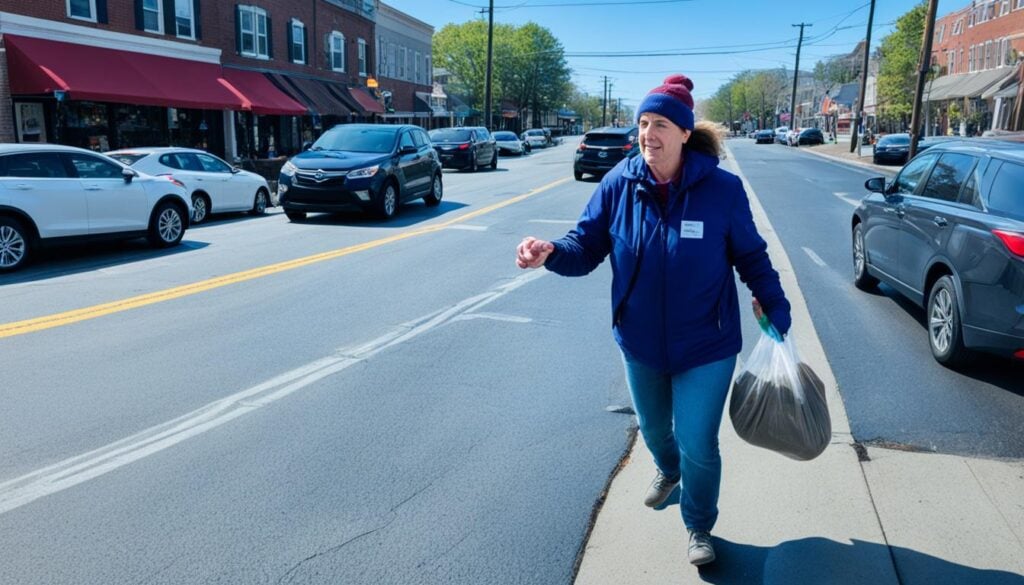Have you ever thought about living in Wilmington without a car? Many people are now looking at how walkable Wilmington is. They want to depend less on cars. In this guide, we’ll see if you can easily walk around Wilmington or if you need a car.
Knowing if you can walk in Wilmington can really improve how you feel about living there. It also helps you connect more with this lively area. Let’s find out about places in Wilmington you can walk to, how to get around, and what you can enjoy in this beautiful coastal city.
Introduction to Wilmington’s Walkability
Wilmington is getting better for people who like to walk. The city now has places that make it easy to walk around. It has worked on combining living, shopping, and fun spaces smoothly.
The city’s efforts to get better at this include making sure there are safe paths and places everyone likes. By designing well, sidewalks and crosswalks bring the city closer together. This lets everyone walk to explore places.
People living in Wilmington have a big say in its walking future. Their opinions shape the planning of the city, meeting everyone’s needs. This team effort encourages walking as a main way to get around.
Exploring Wilmington’s Pedestrian-Friendly Areas
Wilmington has many areas perfect for walking. The city makes sure you can easily get to local amenities. Knowing the best walkable places will make your visit even better.
Top Areas for Walkability
Downtown Wilmington is famous for being pedestrian-friendly. You’ll find streets full of shops, places to eat, and cafes, all close by. This mix of businesses and homes makes walking around enjoyable.
Nearby, parks like the Riverwalk and Greenfield Lake offer beautiful paths. These neighborhoods also focus on creating spaces that are easy to walk around.
Local Amenities Within Walking Distance
Wilmington’s top neighborhoods have everything nearby. They offer:
- Grocery stores like Harris Teeter and Food Lion for convenient shopping.
- Many cafes and restaurants, including Elijah’s and The Basics, serve local dishes.
- Local parks, which provide green spaces for rest and fun activities.
Being able to walk to these places makes Wilmington’s neighborhoods more appealing. It lets you enjoy the city life without needing a car.
Is Wilmington Walkable or Do I Need a Car?
When asking Is Wilmington walkable or do I need a car?, look at many aspects. Wilmington’s charm is a draw for its residents. Yet, the need for a car often depends on their daily life. Different neighborhoods have varying levels of walkability.
In the suburbs, you might have to travel far for stores, schools, and parks. This makes having a car necessary. Meanwhile, downtown Wilmington offers everything close by. Coffee shops, grocery stores, and parks are all within a short walk.
People in Wilmington have different ways of getting around. For example:
| Neighborhood | Walkability Score | Average Distance to Amenities (miles) | Car Ownership Rate (%) |
|---|---|---|---|
| Downtown Wilmington | 85 | 0.5 | 30 |
| Queensboro | 60 | 1.2 | 70 |
| North Wilmington | 45 | 2.5 | 80 |
Downtown is very walkable, but North Wilmington isn’t as much. This shows some places in Wilmington might need you to have a car. Where you decide to live in Wilmington makes a big difference in whether you’ll need a car.
Wilmington Transportation Options
Wilmington has many ways to get around, fitting everyone’s needs. Whether you live here or are visiting, knowing your options makes getting around easier. Public transportation is key for many, making city travel convenient.
Public Transportation Overview
Wave Transit is Wilmington’s main public transportation service. It connects major areas and neighborhoods, making your trips easy. You don’t need a car to get around. They plan to add light rail services soon. This will make commuting and exploring even better.
Alternative Transportation Methods
There are other ways to move around Wilmington besides buses. Biking and walking let you see the city’s beauty up close. Ride-sharing services give you flexibility. Electric scooters are both fun and green for quick rides.
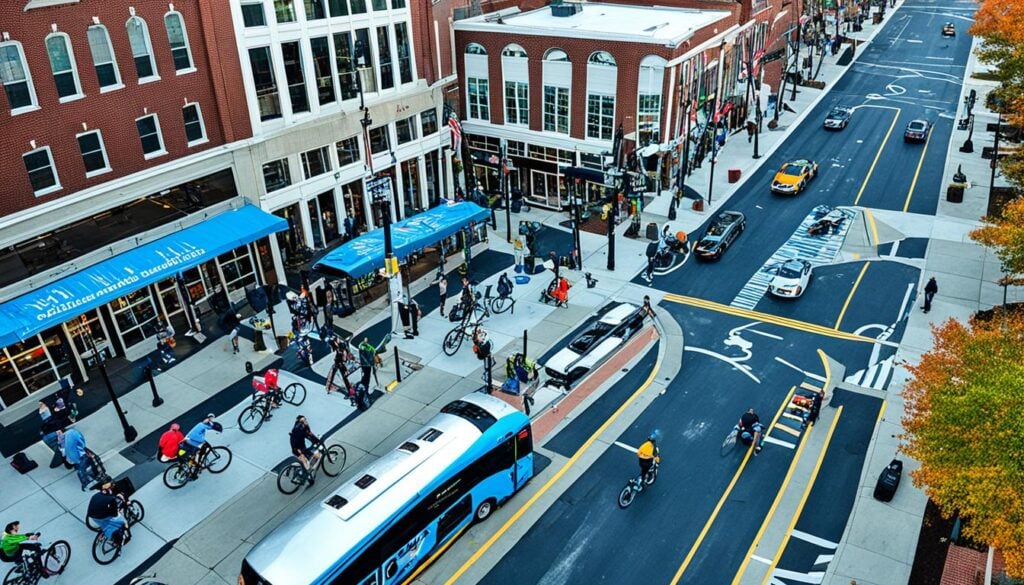
These alternatives keep you active and let you enjoy Wilmington’s charm. Traveling here becomes an adventure, not just a need. Here’s a guide to compare:
| Transportation Method | Pros | Cons |
|---|---|---|
| Wave Transit Bus | Affordable, convenient for long distances | Limited routes, wait times |
| Biking | Healthy, flexible, environmentally friendly | Weather dependent, limited bike lanes |
| Walking | Free, promotes health, deepens city engagement | Time-consuming for long distances |
| Ride-Sharing | Convenient, no need for parking | Cost can add up, surge pricing during peak hours |
| Electric Scooters | Fast, fun, easy to find and rent | Not suitable for long distances, availability may vary |
Every transportation method has its pros and cons. Choose what fits your needs the best. Enjoy everything Wilmington has to offer.
Walkable Neighborhoods in Wilmington
Wilmington has neighborhoods that are easy to walk around in. People who like to get places without a car will love it here. These areas offer a mix of history, water views, and art. They are designed to make walking both easy and enjoyable.
Popular Neighborhoods for Walkers
Some areas are especially good for walking:
- Historic District: It has old streets, beautiful buildings, and lots of shops and parks to visit.
- Riverwalk: A great place for a walk with amazing river views and places to eat.
- Brooklyn Arts District: This area is full of art and places to explore on foot.
Community Features Supporting Walkability
Walkable neighborhoods here have lots of features that help people not use cars:
- Parks and Green Spaces: Public parks add fun places to go and relax on a walk.
- Sidewalks and Pedestrian Zones: There are safe paths that make it easy to walk all over.
- Community Events: Fun events and markets make the neighborhoods friendly and lively.
Getting Around Wilmington Without a Car
Wilmington offers an exciting life without the need for a car. Many folks enjoy moving around this city car-free. They find it not just doable but fun. This way, they benefit their health and the planet, with lots of ways to travel and explore.
Advantages of Car-Free Living
Not having a car brings many upsides to your life. Here are some to think about:
- Cost savings: Ditching vehicle expenses means more money for other things you love.
- Environmental impact: Walking or biking cuts down on pollution, making the earth cleaner.
- Health benefits: More exercise from walking or biking leads to a healthier body and heart.
- Community connection: Getting around without a car helps you get to know your area and neighbors better. You’ll run into cool local spots and fun events.
- Enhanced flexibility: Using public transport or other options often means less stress than driving.
Switching to a life without a car in Wilmington can make your days brighter. You’ll fall more in love with this coastal treasure.
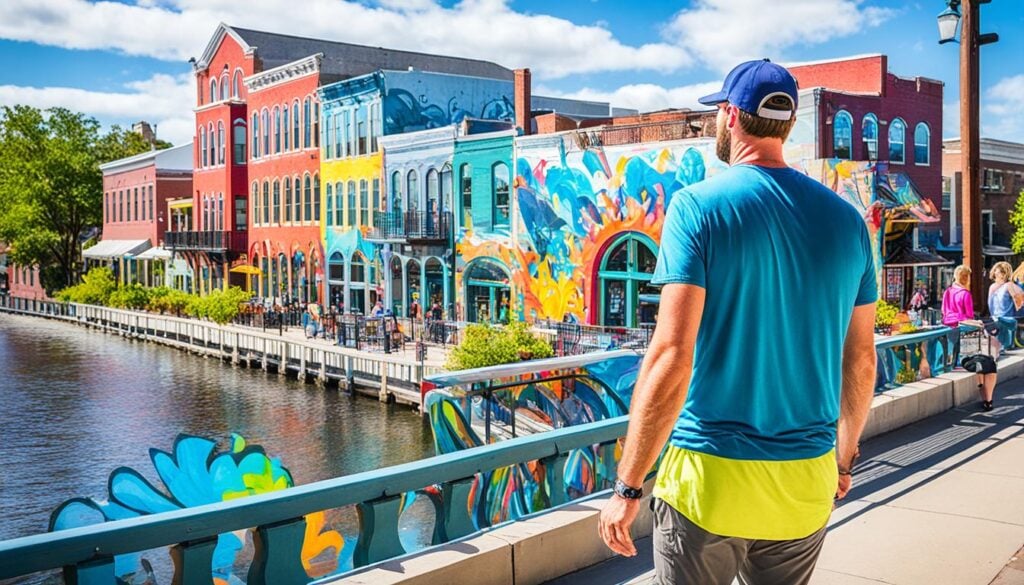
Wilmington Public Transportation: What You Need to Know
Getting to know Wilmington’s public transportation can make your travel easier. It’s easy to get around the city without a car. You can choose from buses, trams, and ride-sharing services based on what works for you.
Bus and Tram Services
Buses and trams are key to getting around in Wilmington. The Delaware Transit Corporation runs these services. They connect important areas across the city.
- They follow regular schedules for easy planning.
- There are many routes to take you different places.
- The fares are low, which helps if you travel a lot.
If you’re going downtown or exploring the suburbs, buses and trams are a good choice. They’re dependable for any trip.
Using Ride-Sharing Services
Ride-sharing services offer a personal travel experience. Uber and Lyft are popular here. They have several perks:
- You can choose when to be picked up.
- Drivers know the best ways to avoid traffic.
- You can book a ride right from your phone.
These services complement Wilmington’s public transportation. They are especially useful when buses or trams aren’t an option.
| Transportation Option | Advantages | Considerations |
|---|---|---|
| Bus and Tram Services | Cost-effective, reliable schedules, covers wide areas | Limited by routes and schedules |
| Ride-Sharing Services | Flexible, convenient, on-demand | Can be more expensive, depends on driver availability |
You have many options to travel around Wilmington without your own car. Discovering what each offers can help you choose the best for your trips.
Walkability Assessment in Wilmington
Evaluating walkability in Wilmington involves looking at its Walk Score and other factors. Scores run from 0 to 100 to show how easy it is to walk in an area. A high score means you’re close to important places and safe streets.
Understanding Wilmington’s Walk Score
The Wilmington Walk Score looks at various elements. These include:
- Land Use: Mixed-use areas mean shops, restaurants, and parks are close by.
- Street Connectivity: Streets that connect well encourage walking and biking.
- Proximity to Amenities: Being near transport, schools, and health services boosts scores.
To paint a clearer picture, here’s a table showing the Walk Scores in Wilmington’s neighborhoods:
| Neighborhood | Walk Score | Highlights |
|---|---|---|
| Downtown Wilmington | 90 | Access to cafes, shops, and cultural spots. |
| Midtown | 85 | Near parks and schools, great for families. |
| Wilmington Riverfront | 80 | Walkable area with food and fun activities. |
| Castle Hayne | 60 | More residential, fewer amenities close by. |
This review shows where Wilmington shines and areas to improve for walking. Knowing this can help you explore Wilmington better and enjoy walking more.
Tips for Embracing a Car-Free Lifestyle in Wilmington
Choosing to live without a car in Wilmington can open up a beautiful world. You get to enjoy nature and connect with lively people around you. To make this lifestyle work, integrate some key strategies into your daily life. Here are tips for embracing a car-free lifestyle that can make the transition smooth.
Essential Items to Keep Handy
Living without a car in Wilmington means you should carry some essentials. These items make your experience better:
- Comfortable Footwear: Get sturdy shoes for walking and biking.
- Reusable Water Bottle: It’s important to stay hydrated, especially on long walks.
- Light Backpack: Carry a durable bag for snacks and personal stuff.
- Public Transport Card: Have an easy way to use public transit.
- Local Map or Navigation App: Know your area well and find your way around easily.
Building a Community Without a Car
Connecting with people can make living without a car in Wilmington better. Here are ways to make friends:
- Join Local Clubs: Be part of walking groups, biking clubs, or environmental groups.
- Attend Community Events: Go to local events, farmers’ markets, and festivals to meet others.
- Volunteer for Local Initiatives: Help with projects that support sustainability and car-free living.
- Social Ryuoups: Meet others living without a car online.
Challenges of Car-Free Living in Wilmington
Going car-free in Wilmington has its own set of challenges. One must identify areas with limited walkability to grasp the challenges of a car-free life. Many suburbs are lovely but lack easy access to basic services on foot.
Areas with Limited Walkability
Wilmington is filled with various neighborhoods, yet accessibility varies. Factors that limit walkability include:
- Sprawling communities require travel over long distances to access shops and services.
- Poor sidewalk conditions make walking unsafe and uncomfortable.
- Lack of regular public transport leaves walkers with few options in remote areas.
Weather Considerations for Walkers
The weather in Wilmington adds to the challenges of car-free living in Wilmington. Summers bring intense heat and humidity that make walking tough. Sudden storms pose dangers for those on foot. To manage, consider these tips:
- Go out in the cooler early mornings or late evenings.
- Drink plenty of water and dress to protect against the sun and heat.
- Watch the weather forecasts to steer clear of surprises from storms.
Conclusion
Wilmington has grown to be more walkable, with many areas and amenities close by. This city is perfect for those wishing to rely less on cars. Yet, what works for one person may not for another when deciding if Wilmington is walkable.
Thinking over a life without a car is key. Wilmington makes a strong case for it with its easy-to-use public transport and walkable areas. The city is moving towards being more friendly to pedestrians. This change supports a healthier, sustainable way of life.
Wilmington is great for those who want to get around without a car. By evaluating your lifestyle and available resources, you can help create a walkable city. This will benefit both you and future generations in Wilmington.

































